Business Research Report: Outsourcing Analysis in Business Context
VerifiedAdded on 2020/03/23
|15
|3083
|58
Report
AI Summary
This business research report delves into the advantages and disadvantages of outsourcing business functions, exploring its impact on companies like Telstra. The report examines project objectives, scope, and a comprehensive literature review, highlighting cost-saving benefits and risk management considerations. The research employs both qualitative and quantitative methodologies, including surveys and interviews, to gather data on outsourcing practices. The study outlines research questions, designs, and methodologies, including sampling techniques and data analysis processes. The report also addresses potential limitations, such as time constraints, and concludes with a summary of findings and references. The analysis provides a detailed overview of the research design, including the use of questionnaires, sampling methods, and data analysis techniques. This report offers valuable insights into the strategic implications of outsourcing in the current business environment.
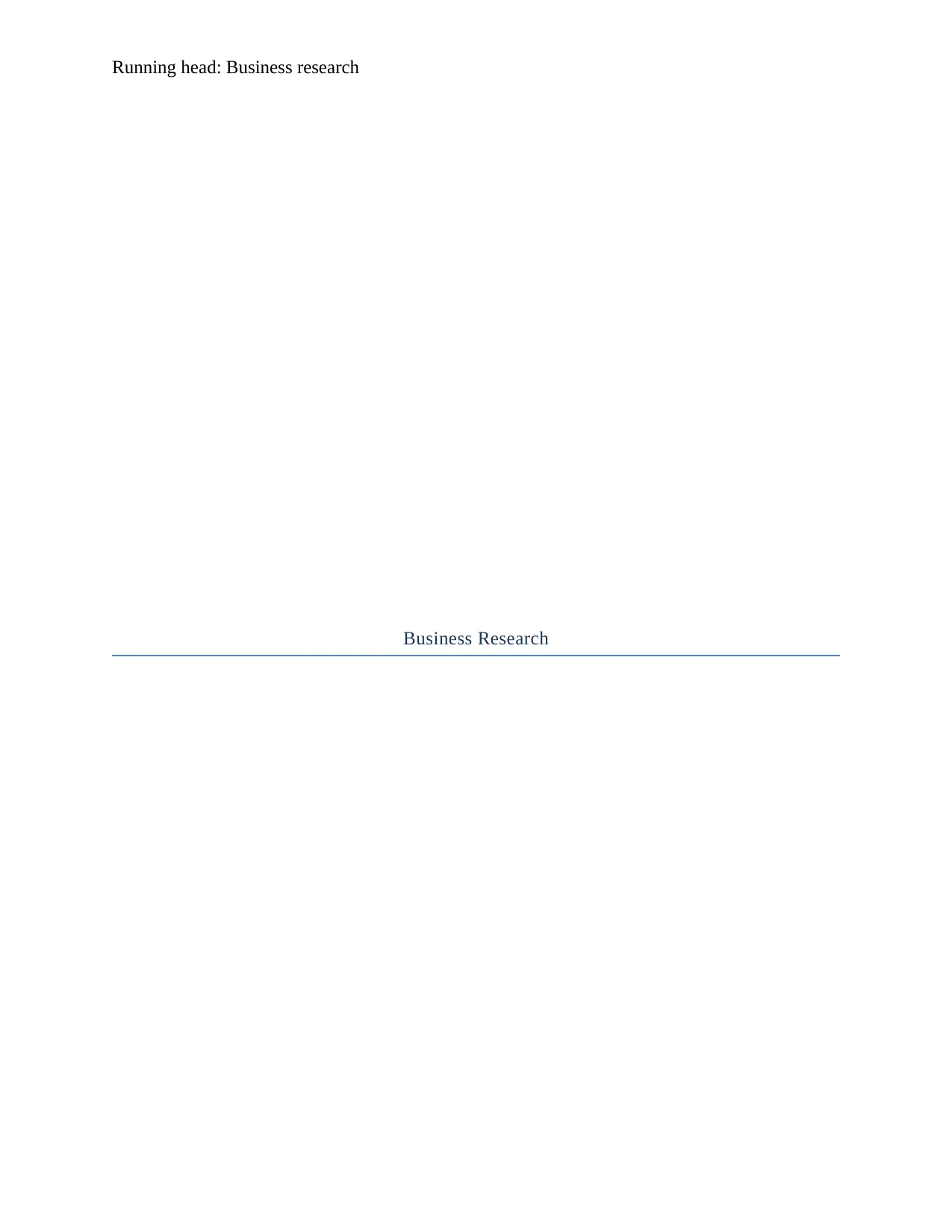
Running head: Business research
Business Research
Business Research
Paraphrase This Document
Need a fresh take? Get an instant paraphrase of this document with our AI Paraphraser
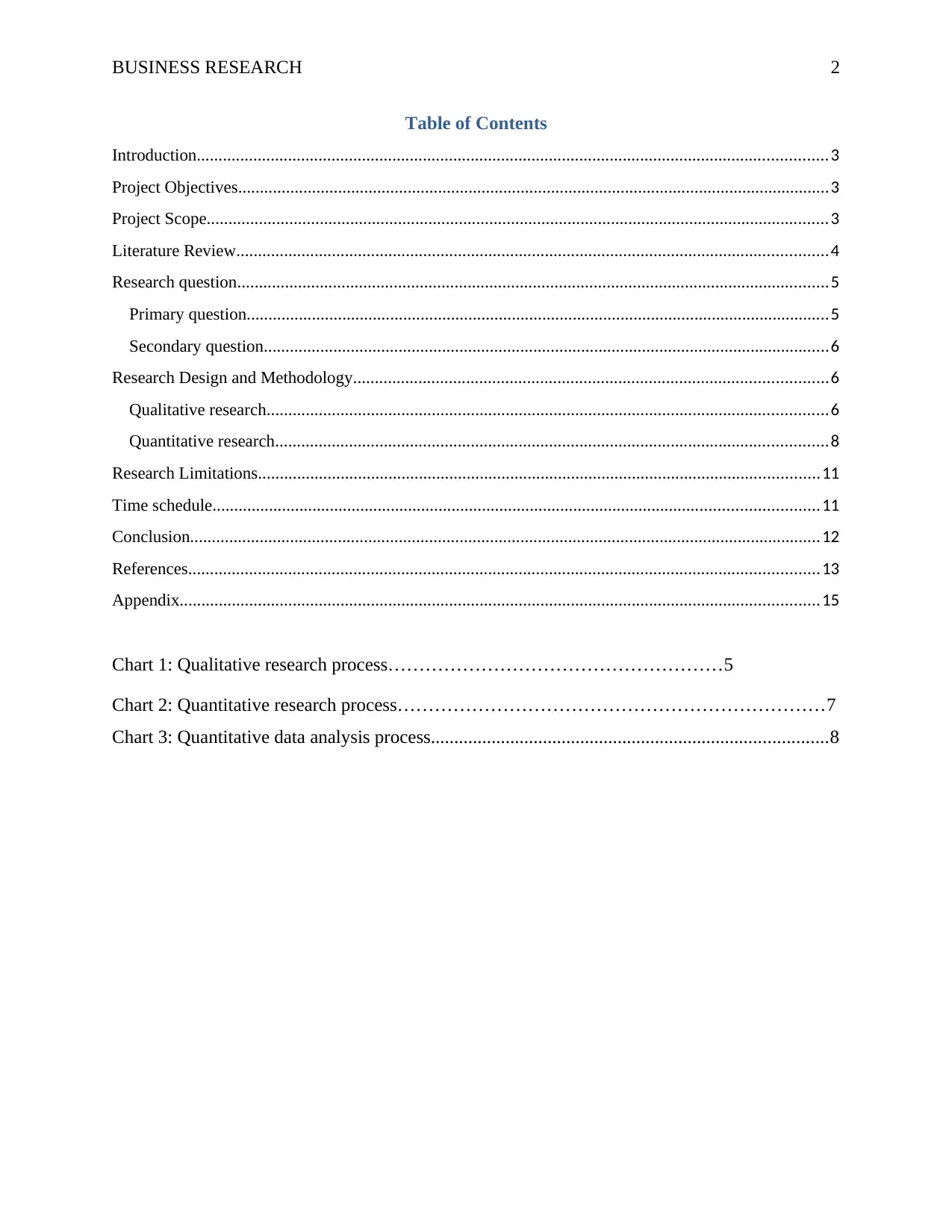
BUSINESS RESEARCH 2
Table of Contents
Introduction.................................................................................................................................................3
Project Objectives........................................................................................................................................3
Project Scope...............................................................................................................................................3
Literature Review........................................................................................................................................4
Research question........................................................................................................................................5
Primary question......................................................................................................................................5
Secondary question..................................................................................................................................6
Research Design and Methodology.............................................................................................................6
Qualitative research.................................................................................................................................6
Quantitative research...............................................................................................................................8
Research Limitations.................................................................................................................................11
Time schedule...........................................................................................................................................11
Conclusion.................................................................................................................................................12
References.................................................................................................................................................13
Appendix...................................................................................................................................................15
Chart 1: Qualitative research process………………………………………………5
Chart 2: Quantitative research process……………………………………………………………7
Chart 3: Quantitative data analysis process.....................................................................................8
Table of Contents
Introduction.................................................................................................................................................3
Project Objectives........................................................................................................................................3
Project Scope...............................................................................................................................................3
Literature Review........................................................................................................................................4
Research question........................................................................................................................................5
Primary question......................................................................................................................................5
Secondary question..................................................................................................................................6
Research Design and Methodology.............................................................................................................6
Qualitative research.................................................................................................................................6
Quantitative research...............................................................................................................................8
Research Limitations.................................................................................................................................11
Time schedule...........................................................................................................................................11
Conclusion.................................................................................................................................................12
References.................................................................................................................................................13
Appendix...................................................................................................................................................15
Chart 1: Qualitative research process………………………………………………5
Chart 2: Quantitative research process……………………………………………………………7
Chart 3: Quantitative data analysis process.....................................................................................8
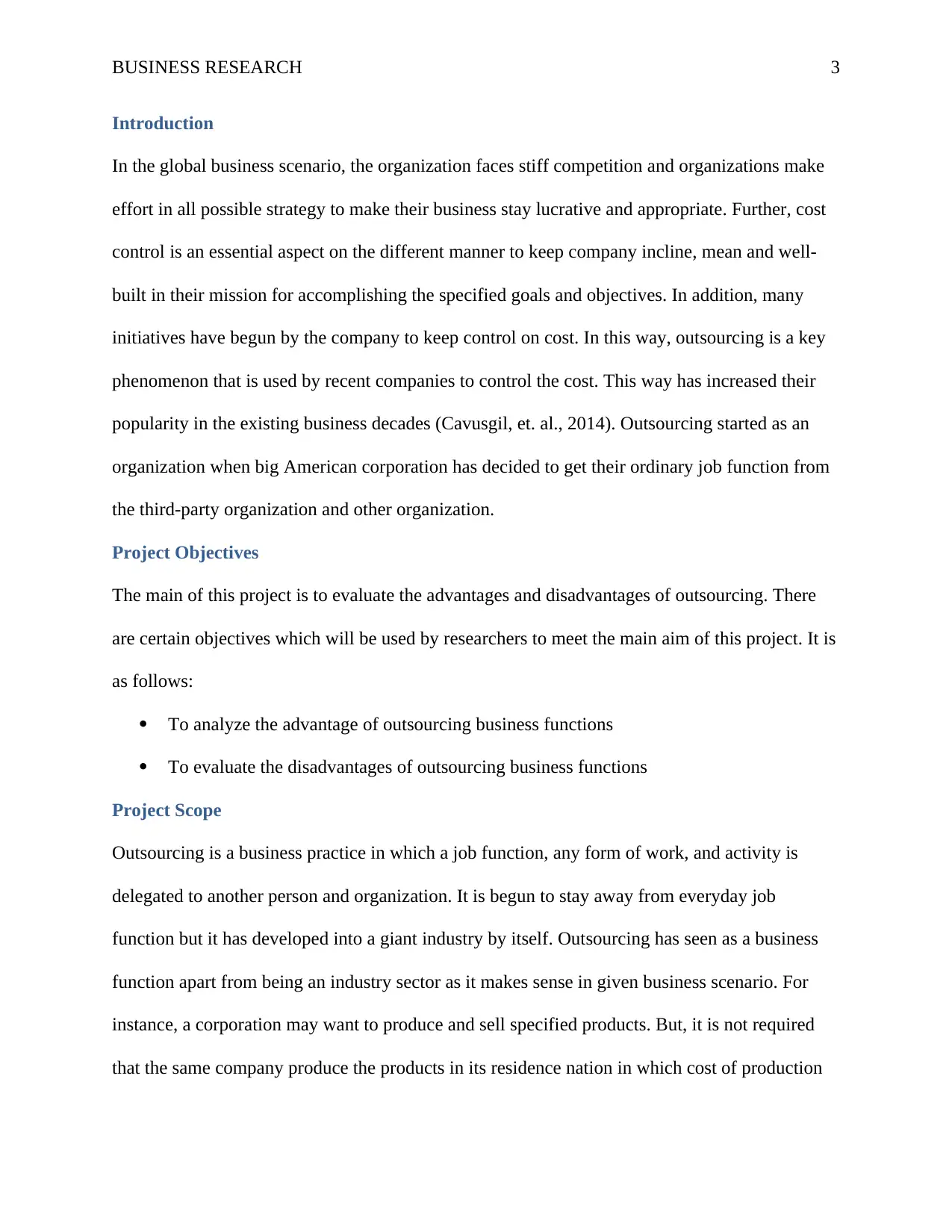
BUSINESS RESEARCH 3
Introduction
In the global business scenario, the organization faces stiff competition and organizations make
effort in all possible strategy to make their business stay lucrative and appropriate. Further, cost
control is an essential aspect on the different manner to keep company incline, mean and well-
built in their mission for accomplishing the specified goals and objectives. In addition, many
initiatives have begun by the company to keep control on cost. In this way, outsourcing is a key
phenomenon that is used by recent companies to control the cost. This way has increased their
popularity in the existing business decades (Cavusgil, et. al., 2014). Outsourcing started as an
organization when big American corporation has decided to get their ordinary job function from
the third-party organization and other organization.
Project Objectives
The main of this project is to evaluate the advantages and disadvantages of outsourcing. There
are certain objectives which will be used by researchers to meet the main aim of this project. It is
as follows:
To analyze the advantage of outsourcing business functions
To evaluate the disadvantages of outsourcing business functions
Project Scope
Outsourcing is a business practice in which a job function, any form of work, and activity is
delegated to another person and organization. It is begun to stay away from everyday job
function but it has developed into a giant industry by itself. Outsourcing has seen as a business
function apart from being an industry sector as it makes sense in given business scenario. For
instance, a corporation may want to produce and sell specified products. But, it is not required
that the same company produce the products in its residence nation in which cost of production
Introduction
In the global business scenario, the organization faces stiff competition and organizations make
effort in all possible strategy to make their business stay lucrative and appropriate. Further, cost
control is an essential aspect on the different manner to keep company incline, mean and well-
built in their mission for accomplishing the specified goals and objectives. In addition, many
initiatives have begun by the company to keep control on cost. In this way, outsourcing is a key
phenomenon that is used by recent companies to control the cost. This way has increased their
popularity in the existing business decades (Cavusgil, et. al., 2014). Outsourcing started as an
organization when big American corporation has decided to get their ordinary job function from
the third-party organization and other organization.
Project Objectives
The main of this project is to evaluate the advantages and disadvantages of outsourcing. There
are certain objectives which will be used by researchers to meet the main aim of this project. It is
as follows:
To analyze the advantage of outsourcing business functions
To evaluate the disadvantages of outsourcing business functions
Project Scope
Outsourcing is a business practice in which a job function, any form of work, and activity is
delegated to another person and organization. It is begun to stay away from everyday job
function but it has developed into a giant industry by itself. Outsourcing has seen as a business
function apart from being an industry sector as it makes sense in given business scenario. For
instance, a corporation may want to produce and sell specified products. But, it is not required
that the same company produce the products in its residence nation in which cost of production
⊘ This is a preview!⊘
Do you want full access?
Subscribe today to unlock all pages.

Trusted by 1+ million students worldwide
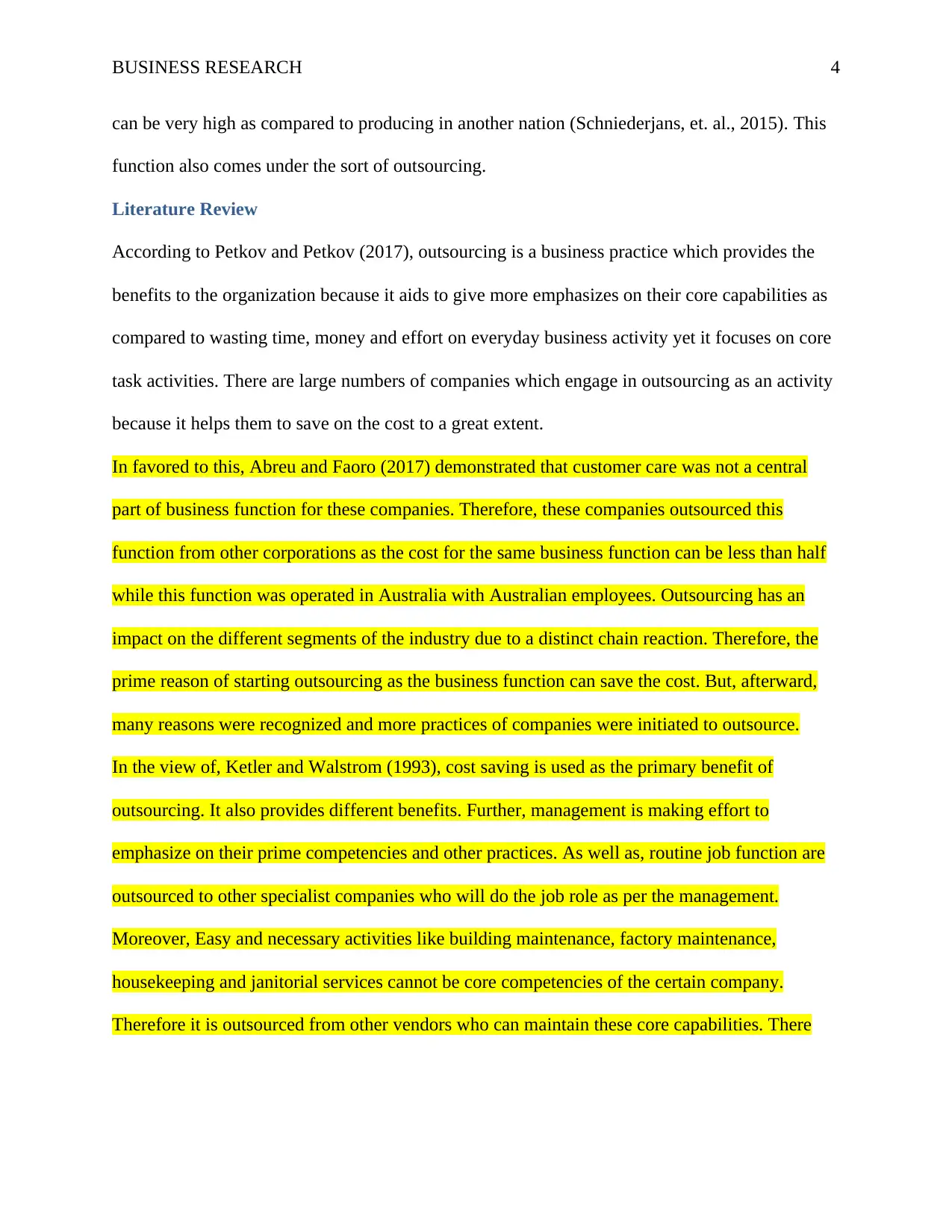
BUSINESS RESEARCH 4
can be very high as compared to producing in another nation (Schniederjans, et. al., 2015). This
function also comes under the sort of outsourcing.
Literature Review
According to Petkov and Petkov (2017), outsourcing is a business practice which provides the
benefits to the organization because it aids to give more emphasizes on their core capabilities as
compared to wasting time, money and effort on everyday business activity yet it focuses on core
task activities. There are large numbers of companies which engage in outsourcing as an activity
because it helps them to save on the cost to a great extent.
In favored to this, Abreu and Faoro (2017) demonstrated that customer care was not a central
part of business function for these companies. Therefore, these companies outsourced this
function from other corporations as the cost for the same business function can be less than half
while this function was operated in Australia with Australian employees. Outsourcing has an
impact on the different segments of the industry due to a distinct chain reaction. Therefore, the
prime reason of starting outsourcing as the business function can save the cost. But, afterward,
many reasons were recognized and more practices of companies were initiated to outsource.
In the view of, Ketler and Walstrom (1993), cost saving is used as the primary benefit of
outsourcing. It also provides different benefits. Further, management is making effort to
emphasize on their prime competencies and other practices. As well as, routine job function are
outsourced to other specialist companies who will do the job role as per the management.
Moreover, Easy and necessary activities like building maintenance, factory maintenance,
housekeeping and janitorial services cannot be core competencies of the certain company.
Therefore it is outsourced from other vendors who can maintain these core capabilities. There
can be very high as compared to producing in another nation (Schniederjans, et. al., 2015). This
function also comes under the sort of outsourcing.
Literature Review
According to Petkov and Petkov (2017), outsourcing is a business practice which provides the
benefits to the organization because it aids to give more emphasizes on their core capabilities as
compared to wasting time, money and effort on everyday business activity yet it focuses on core
task activities. There are large numbers of companies which engage in outsourcing as an activity
because it helps them to save on the cost to a great extent.
In favored to this, Abreu and Faoro (2017) demonstrated that customer care was not a central
part of business function for these companies. Therefore, these companies outsourced this
function from other corporations as the cost for the same business function can be less than half
while this function was operated in Australia with Australian employees. Outsourcing has an
impact on the different segments of the industry due to a distinct chain reaction. Therefore, the
prime reason of starting outsourcing as the business function can save the cost. But, afterward,
many reasons were recognized and more practices of companies were initiated to outsource.
In the view of, Ketler and Walstrom (1993), cost saving is used as the primary benefit of
outsourcing. It also provides different benefits. Further, management is making effort to
emphasize on their prime competencies and other practices. As well as, routine job function are
outsourced to other specialist companies who will do the job role as per the management.
Moreover, Easy and necessary activities like building maintenance, factory maintenance,
housekeeping and janitorial services cannot be core competencies of the certain company.
Therefore it is outsourced from other vendors who can maintain these core capabilities. There
Paraphrase This Document
Need a fresh take? Get an instant paraphrase of this document with our AI Paraphraser
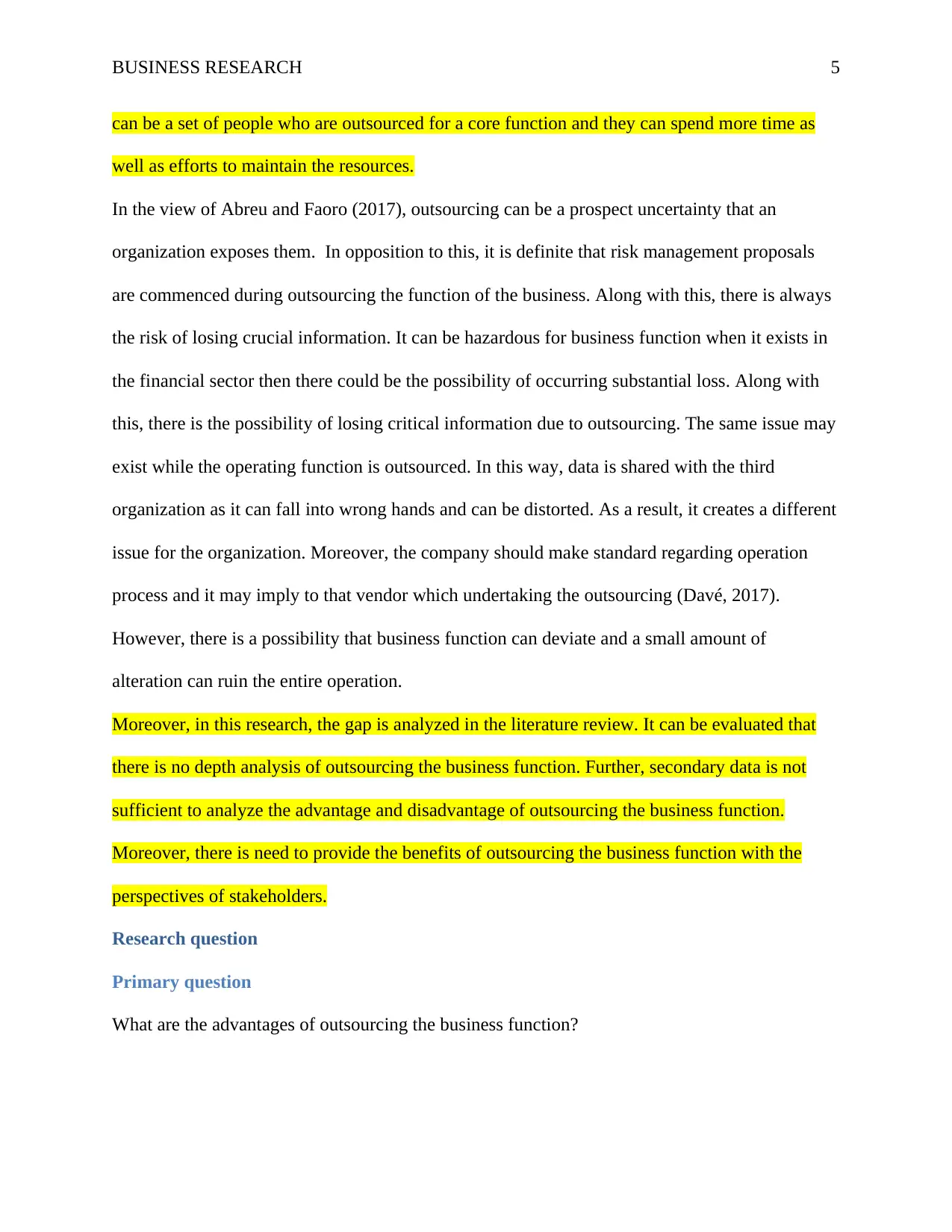
BUSINESS RESEARCH 5
can be a set of people who are outsourced for a core function and they can spend more time as
well as efforts to maintain the resources.
In the view of Abreu and Faoro (2017), outsourcing can be a prospect uncertainty that an
organization exposes them. In opposition to this, it is definite that risk management proposals
are commenced during outsourcing the function of the business. Along with this, there is always
the risk of losing crucial information. It can be hazardous for business function when it exists in
the financial sector then there could be the possibility of occurring substantial loss. Along with
this, there is the possibility of losing critical information due to outsourcing. The same issue may
exist while the operating function is outsourced. In this way, data is shared with the third
organization as it can fall into wrong hands and can be distorted. As a result, it creates a different
issue for the organization. Moreover, the company should make standard regarding operation
process and it may imply to that vendor which undertaking the outsourcing (Davé, 2017).
However, there is a possibility that business function can deviate and a small amount of
alteration can ruin the entire operation.
Moreover, in this research, the gap is analyzed in the literature review. It can be evaluated that
there is no depth analysis of outsourcing the business function. Further, secondary data is not
sufficient to analyze the advantage and disadvantage of outsourcing the business function.
Moreover, there is need to provide the benefits of outsourcing the business function with the
perspectives of stakeholders.
Research question
Primary question
What are the advantages of outsourcing the business function?
can be a set of people who are outsourced for a core function and they can spend more time as
well as efforts to maintain the resources.
In the view of Abreu and Faoro (2017), outsourcing can be a prospect uncertainty that an
organization exposes them. In opposition to this, it is definite that risk management proposals
are commenced during outsourcing the function of the business. Along with this, there is always
the risk of losing crucial information. It can be hazardous for business function when it exists in
the financial sector then there could be the possibility of occurring substantial loss. Along with
this, there is the possibility of losing critical information due to outsourcing. The same issue may
exist while the operating function is outsourced. In this way, data is shared with the third
organization as it can fall into wrong hands and can be distorted. As a result, it creates a different
issue for the organization. Moreover, the company should make standard regarding operation
process and it may imply to that vendor which undertaking the outsourcing (Davé, 2017).
However, there is a possibility that business function can deviate and a small amount of
alteration can ruin the entire operation.
Moreover, in this research, the gap is analyzed in the literature review. It can be evaluated that
there is no depth analysis of outsourcing the business function. Further, secondary data is not
sufficient to analyze the advantage and disadvantage of outsourcing the business function.
Moreover, there is need to provide the benefits of outsourcing the business function with the
perspectives of stakeholders.
Research question
Primary question
What are the advantages of outsourcing the business function?
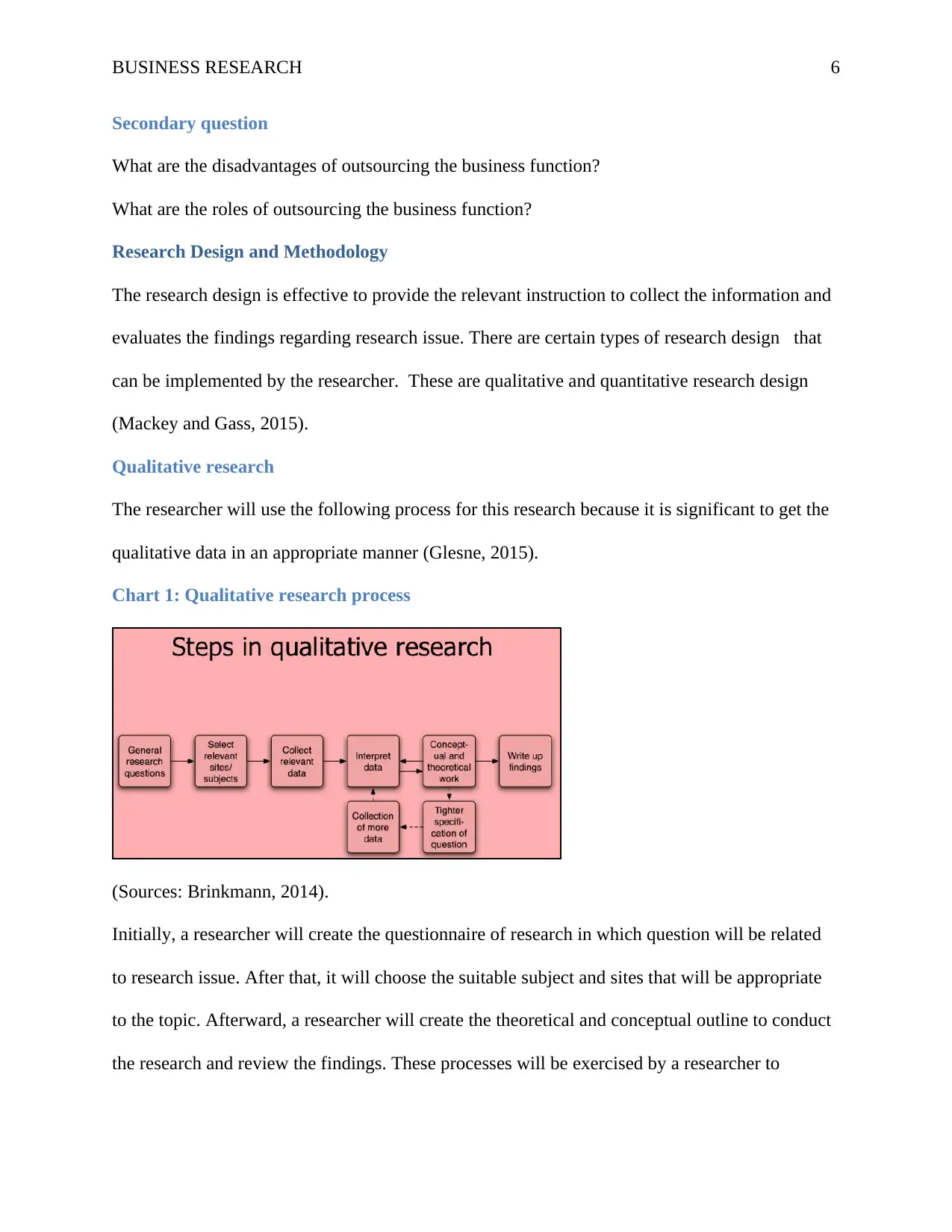
BUSINESS RESEARCH 6
Secondary question
What are the disadvantages of outsourcing the business function?
What are the roles of outsourcing the business function?
Research Design and Methodology
The research design is effective to provide the relevant instruction to collect the information and
evaluates the findings regarding research issue. There are certain types of research design that
can be implemented by the researcher. These are qualitative and quantitative research design
(Mackey and Gass, 2015).
Qualitative research
The researcher will use the following process for this research because it is significant to get the
qualitative data in an appropriate manner (Glesne, 2015).
Chart 1: Qualitative research process
(Sources: Brinkmann, 2014).
Initially, a researcher will create the questionnaire of research in which question will be related
to research issue. After that, it will choose the suitable subject and sites that will be appropriate
to the topic. Afterward, a researcher will create the theoretical and conceptual outline to conduct
the research and review the findings. These processes will be exercised by a researcher to
Secondary question
What are the disadvantages of outsourcing the business function?
What are the roles of outsourcing the business function?
Research Design and Methodology
The research design is effective to provide the relevant instruction to collect the information and
evaluates the findings regarding research issue. There are certain types of research design that
can be implemented by the researcher. These are qualitative and quantitative research design
(Mackey and Gass, 2015).
Qualitative research
The researcher will use the following process for this research because it is significant to get the
qualitative data in an appropriate manner (Glesne, 2015).
Chart 1: Qualitative research process
(Sources: Brinkmann, 2014).
Initially, a researcher will create the questionnaire of research in which question will be related
to research issue. After that, it will choose the suitable subject and sites that will be appropriate
to the topic. Afterward, a researcher will create the theoretical and conceptual outline to conduct
the research and review the findings. These processes will be exercised by a researcher to
⊘ This is a preview!⊘
Do you want full access?
Subscribe today to unlock all pages.

Trusted by 1+ million students worldwide
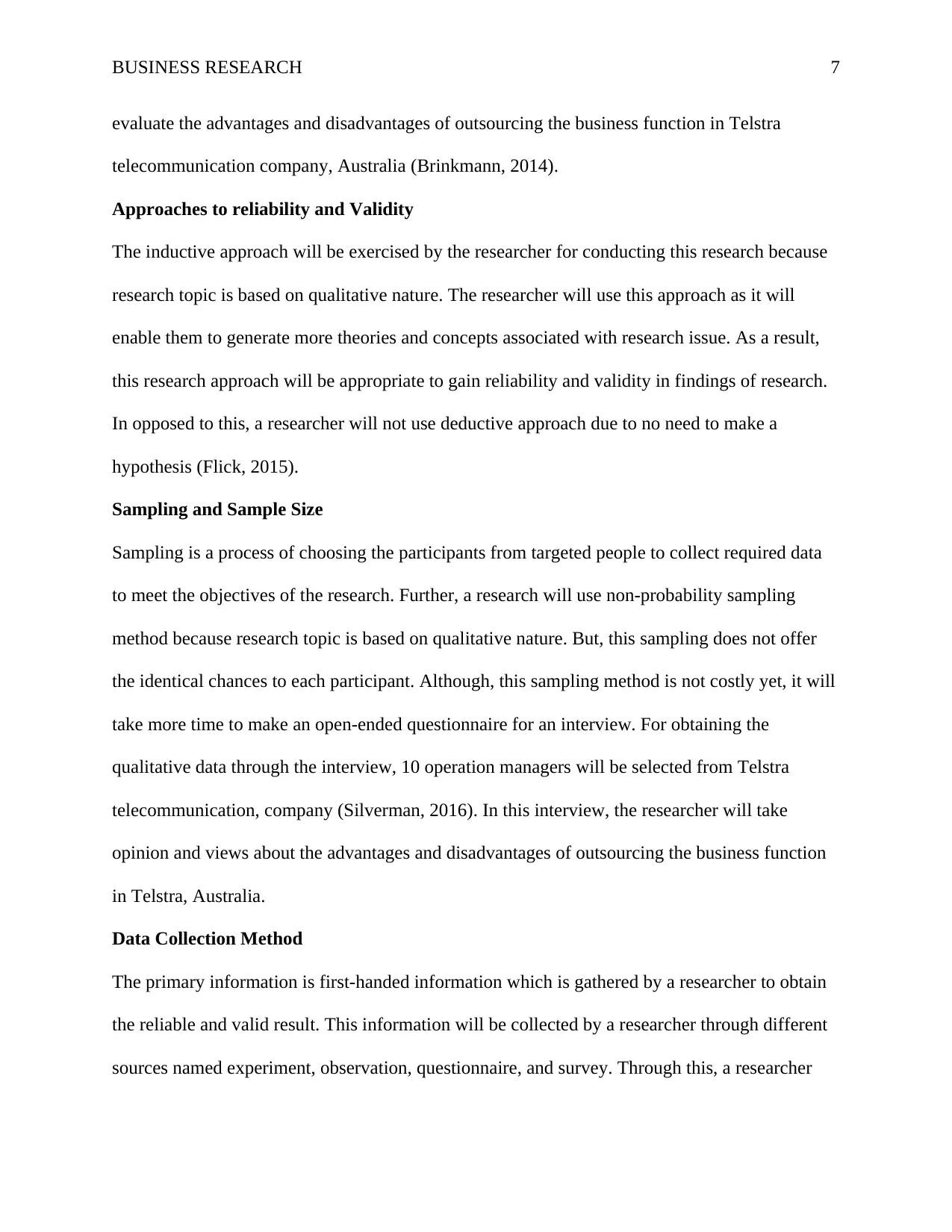
BUSINESS RESEARCH 7
evaluate the advantages and disadvantages of outsourcing the business function in Telstra
telecommunication company, Australia (Brinkmann, 2014).
Approaches to reliability and Validity
The inductive approach will be exercised by the researcher for conducting this research because
research topic is based on qualitative nature. The researcher will use this approach as it will
enable them to generate more theories and concepts associated with research issue. As a result,
this research approach will be appropriate to gain reliability and validity in findings of research.
In opposed to this, a researcher will not use deductive approach due to no need to make a
hypothesis (Flick, 2015).
Sampling and Sample Size
Sampling is a process of choosing the participants from targeted people to collect required data
to meet the objectives of the research. Further, a research will use non-probability sampling
method because research topic is based on qualitative nature. But, this sampling does not offer
the identical chances to each participant. Although, this sampling method is not costly yet, it will
take more time to make an open-ended questionnaire for an interview. For obtaining the
qualitative data through the interview, 10 operation managers will be selected from Telstra
telecommunication, company (Silverman, 2016). In this interview, the researcher will take
opinion and views about the advantages and disadvantages of outsourcing the business function
in Telstra, Australia.
Data Collection Method
The primary information is first-handed information which is gathered by a researcher to obtain
the reliable and valid result. This information will be collected by a researcher through different
sources named experiment, observation, questionnaire, and survey. Through this, a researcher
evaluate the advantages and disadvantages of outsourcing the business function in Telstra
telecommunication company, Australia (Brinkmann, 2014).
Approaches to reliability and Validity
The inductive approach will be exercised by the researcher for conducting this research because
research topic is based on qualitative nature. The researcher will use this approach as it will
enable them to generate more theories and concepts associated with research issue. As a result,
this research approach will be appropriate to gain reliability and validity in findings of research.
In opposed to this, a researcher will not use deductive approach due to no need to make a
hypothesis (Flick, 2015).
Sampling and Sample Size
Sampling is a process of choosing the participants from targeted people to collect required data
to meet the objectives of the research. Further, a research will use non-probability sampling
method because research topic is based on qualitative nature. But, this sampling does not offer
the identical chances to each participant. Although, this sampling method is not costly yet, it will
take more time to make an open-ended questionnaire for an interview. For obtaining the
qualitative data through the interview, 10 operation managers will be selected from Telstra
telecommunication, company (Silverman, 2016). In this interview, the researcher will take
opinion and views about the advantages and disadvantages of outsourcing the business function
in Telstra, Australia.
Data Collection Method
The primary information is first-handed information which is gathered by a researcher to obtain
the reliable and valid result. This information will be collected by a researcher through different
sources named experiment, observation, questionnaire, and survey. Through this, a researcher
Paraphrase This Document
Need a fresh take? Get an instant paraphrase of this document with our AI Paraphraser
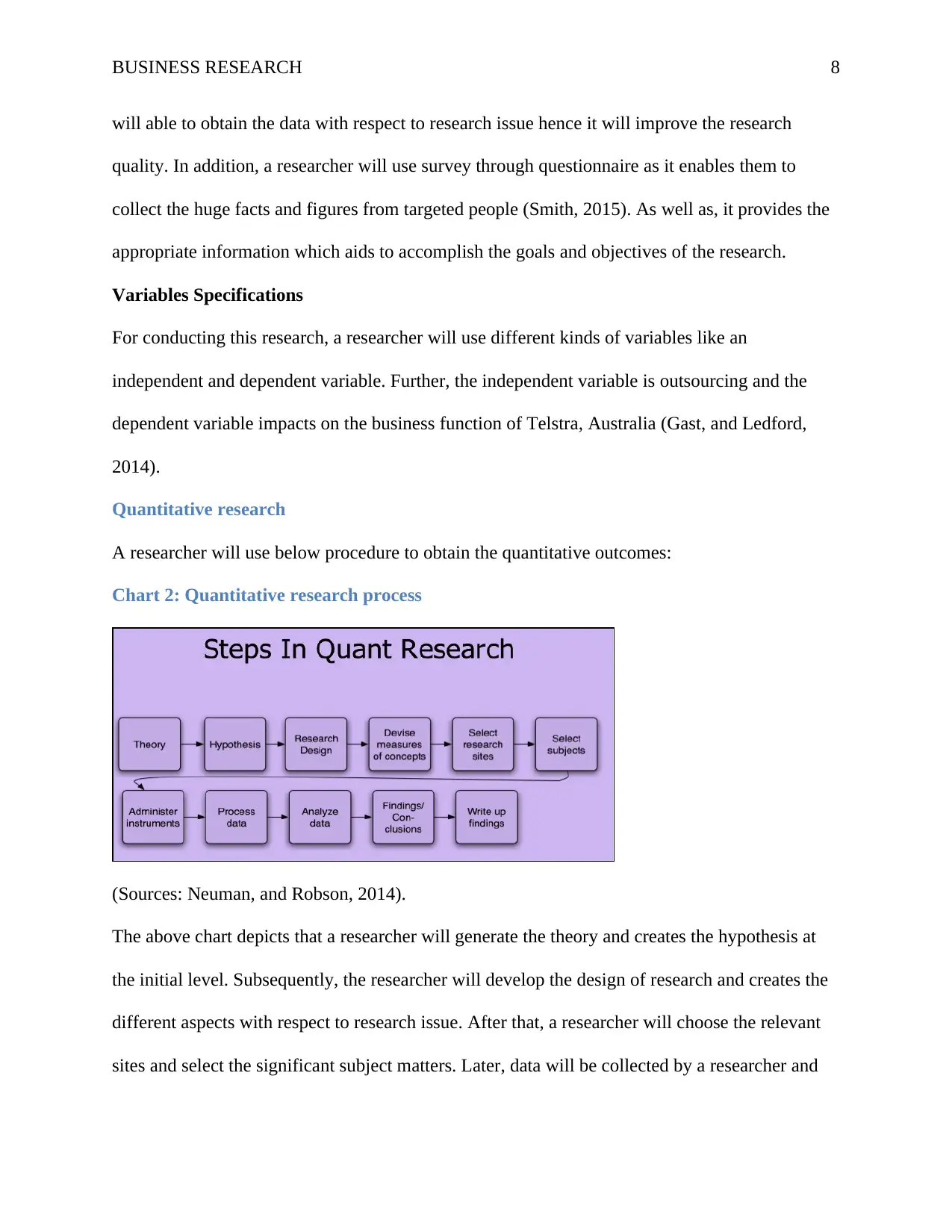
BUSINESS RESEARCH 8
will able to obtain the data with respect to research issue hence it will improve the research
quality. In addition, a researcher will use survey through questionnaire as it enables them to
collect the huge facts and figures from targeted people (Smith, 2015). As well as, it provides the
appropriate information which aids to accomplish the goals and objectives of the research.
Variables Specifications
For conducting this research, a researcher will use different kinds of variables like an
independent and dependent variable. Further, the independent variable is outsourcing and the
dependent variable impacts on the business function of Telstra, Australia (Gast, and Ledford,
2014).
Quantitative research
A researcher will use below procedure to obtain the quantitative outcomes:
Chart 2: Quantitative research process
(Sources: Neuman, and Robson, 2014).
The above chart depicts that a researcher will generate the theory and creates the hypothesis at
the initial level. Subsequently, the researcher will develop the design of research and creates the
different aspects with respect to research issue. After that, a researcher will choose the relevant
sites and select the significant subject matters. Later, data will be collected by a researcher and
will able to obtain the data with respect to research issue hence it will improve the research
quality. In addition, a researcher will use survey through questionnaire as it enables them to
collect the huge facts and figures from targeted people (Smith, 2015). As well as, it provides the
appropriate information which aids to accomplish the goals and objectives of the research.
Variables Specifications
For conducting this research, a researcher will use different kinds of variables like an
independent and dependent variable. Further, the independent variable is outsourcing and the
dependent variable impacts on the business function of Telstra, Australia (Gast, and Ledford,
2014).
Quantitative research
A researcher will use below procedure to obtain the quantitative outcomes:
Chart 2: Quantitative research process
(Sources: Neuman, and Robson, 2014).
The above chart depicts that a researcher will generate the theory and creates the hypothesis at
the initial level. Subsequently, the researcher will develop the design of research and creates the
different aspects with respect to research issue. After that, a researcher will choose the relevant
sites and select the significant subject matters. Later, data will be collected by a researcher and
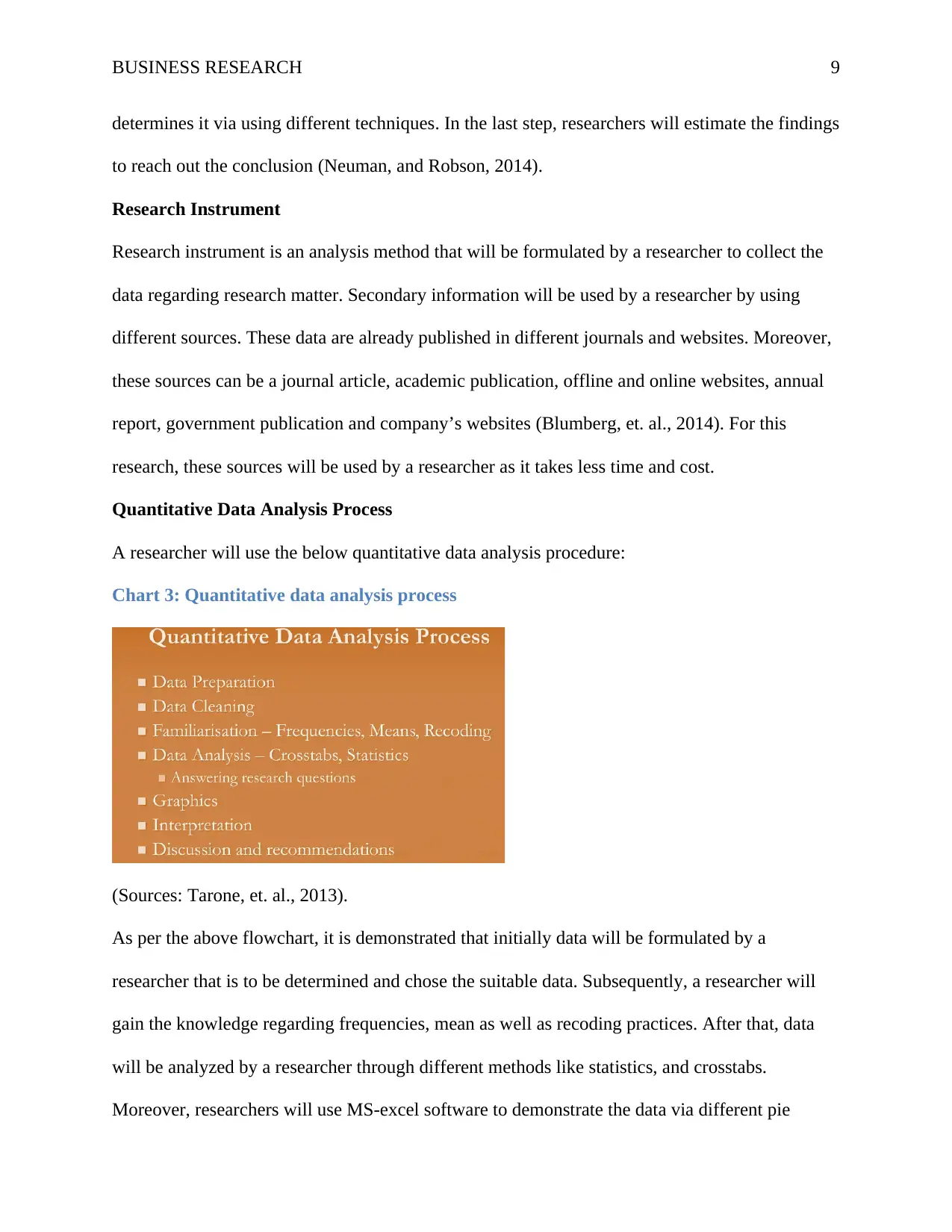
BUSINESS RESEARCH 9
determines it via using different techniques. In the last step, researchers will estimate the findings
to reach out the conclusion (Neuman, and Robson, 2014).
Research Instrument
Research instrument is an analysis method that will be formulated by a researcher to collect the
data regarding research matter. Secondary information will be used by a researcher by using
different sources. These data are already published in different journals and websites. Moreover,
these sources can be a journal article, academic publication, offline and online websites, annual
report, government publication and company’s websites (Blumberg, et. al., 2014). For this
research, these sources will be used by a researcher as it takes less time and cost.
Quantitative Data Analysis Process
A researcher will use the below quantitative data analysis procedure:
Chart 3: Quantitative data analysis process
(Sources: Tarone, et. al., 2013).
As per the above flowchart, it is demonstrated that initially data will be formulated by a
researcher that is to be determined and chose the suitable data. Subsequently, a researcher will
gain the knowledge regarding frequencies, mean as well as recoding practices. After that, data
will be analyzed by a researcher through different methods like statistics, and crosstabs.
Moreover, researchers will use MS-excel software to demonstrate the data via different pie
determines it via using different techniques. In the last step, researchers will estimate the findings
to reach out the conclusion (Neuman, and Robson, 2014).
Research Instrument
Research instrument is an analysis method that will be formulated by a researcher to collect the
data regarding research matter. Secondary information will be used by a researcher by using
different sources. These data are already published in different journals and websites. Moreover,
these sources can be a journal article, academic publication, offline and online websites, annual
report, government publication and company’s websites (Blumberg, et. al., 2014). For this
research, these sources will be used by a researcher as it takes less time and cost.
Quantitative Data Analysis Process
A researcher will use the below quantitative data analysis procedure:
Chart 3: Quantitative data analysis process
(Sources: Tarone, et. al., 2013).
As per the above flowchart, it is demonstrated that initially data will be formulated by a
researcher that is to be determined and chose the suitable data. Subsequently, a researcher will
gain the knowledge regarding frequencies, mean as well as recoding practices. After that, data
will be analyzed by a researcher through different methods like statistics, and crosstabs.
Moreover, researchers will use MS-excel software to demonstrate the data via different pie
⊘ This is a preview!⊘
Do you want full access?
Subscribe today to unlock all pages.

Trusted by 1+ million students worldwide
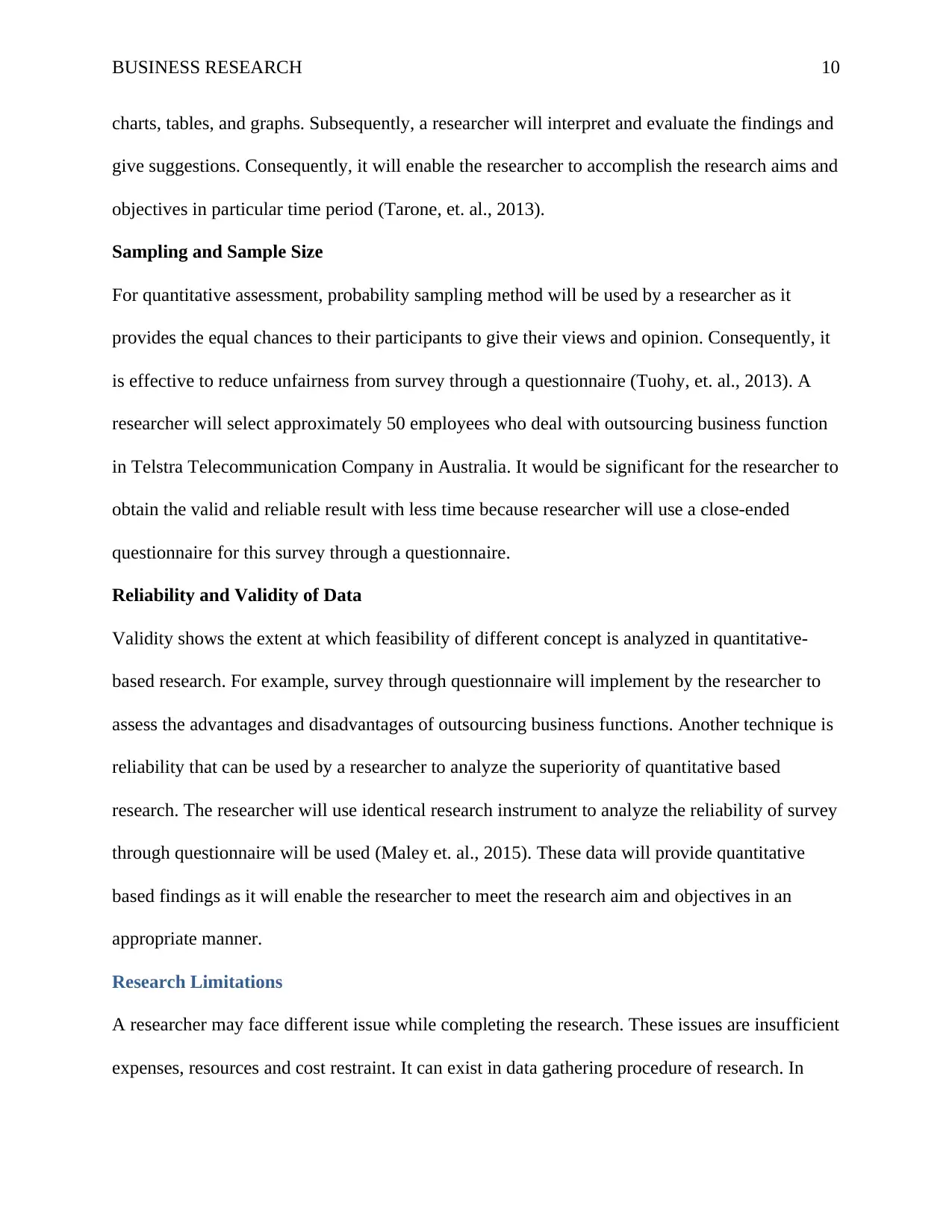
BUSINESS RESEARCH 10
charts, tables, and graphs. Subsequently, a researcher will interpret and evaluate the findings and
give suggestions. Consequently, it will enable the researcher to accomplish the research aims and
objectives in particular time period (Tarone, et. al., 2013).
Sampling and Sample Size
For quantitative assessment, probability sampling method will be used by a researcher as it
provides the equal chances to their participants to give their views and opinion. Consequently, it
is effective to reduce unfairness from survey through a questionnaire (Tuohy, et. al., 2013). A
researcher will select approximately 50 employees who deal with outsourcing business function
in Telstra Telecommunication Company in Australia. It would be significant for the researcher to
obtain the valid and reliable result with less time because researcher will use a close-ended
questionnaire for this survey through a questionnaire.
Reliability and Validity of Data
Validity shows the extent at which feasibility of different concept is analyzed in quantitative-
based research. For example, survey through questionnaire will implement by the researcher to
assess the advantages and disadvantages of outsourcing business functions. Another technique is
reliability that can be used by a researcher to analyze the superiority of quantitative based
research. The researcher will use identical research instrument to analyze the reliability of survey
through questionnaire will be used (Maley et. al., 2015). These data will provide quantitative
based findings as it will enable the researcher to meet the research aim and objectives in an
appropriate manner.
Research Limitations
A researcher may face different issue while completing the research. These issues are insufficient
expenses, resources and cost restraint. It can exist in data gathering procedure of research. In
charts, tables, and graphs. Subsequently, a researcher will interpret and evaluate the findings and
give suggestions. Consequently, it will enable the researcher to accomplish the research aims and
objectives in particular time period (Tarone, et. al., 2013).
Sampling and Sample Size
For quantitative assessment, probability sampling method will be used by a researcher as it
provides the equal chances to their participants to give their views and opinion. Consequently, it
is effective to reduce unfairness from survey through a questionnaire (Tuohy, et. al., 2013). A
researcher will select approximately 50 employees who deal with outsourcing business function
in Telstra Telecommunication Company in Australia. It would be significant for the researcher to
obtain the valid and reliable result with less time because researcher will use a close-ended
questionnaire for this survey through a questionnaire.
Reliability and Validity of Data
Validity shows the extent at which feasibility of different concept is analyzed in quantitative-
based research. For example, survey through questionnaire will implement by the researcher to
assess the advantages and disadvantages of outsourcing business functions. Another technique is
reliability that can be used by a researcher to analyze the superiority of quantitative based
research. The researcher will use identical research instrument to analyze the reliability of survey
through questionnaire will be used (Maley et. al., 2015). These data will provide quantitative
based findings as it will enable the researcher to meet the research aim and objectives in an
appropriate manner.
Research Limitations
A researcher may face different issue while completing the research. These issues are insufficient
expenses, resources and cost restraint. It can exist in data gathering procedure of research. In
Paraphrase This Document
Need a fresh take? Get an instant paraphrase of this document with our AI Paraphraser
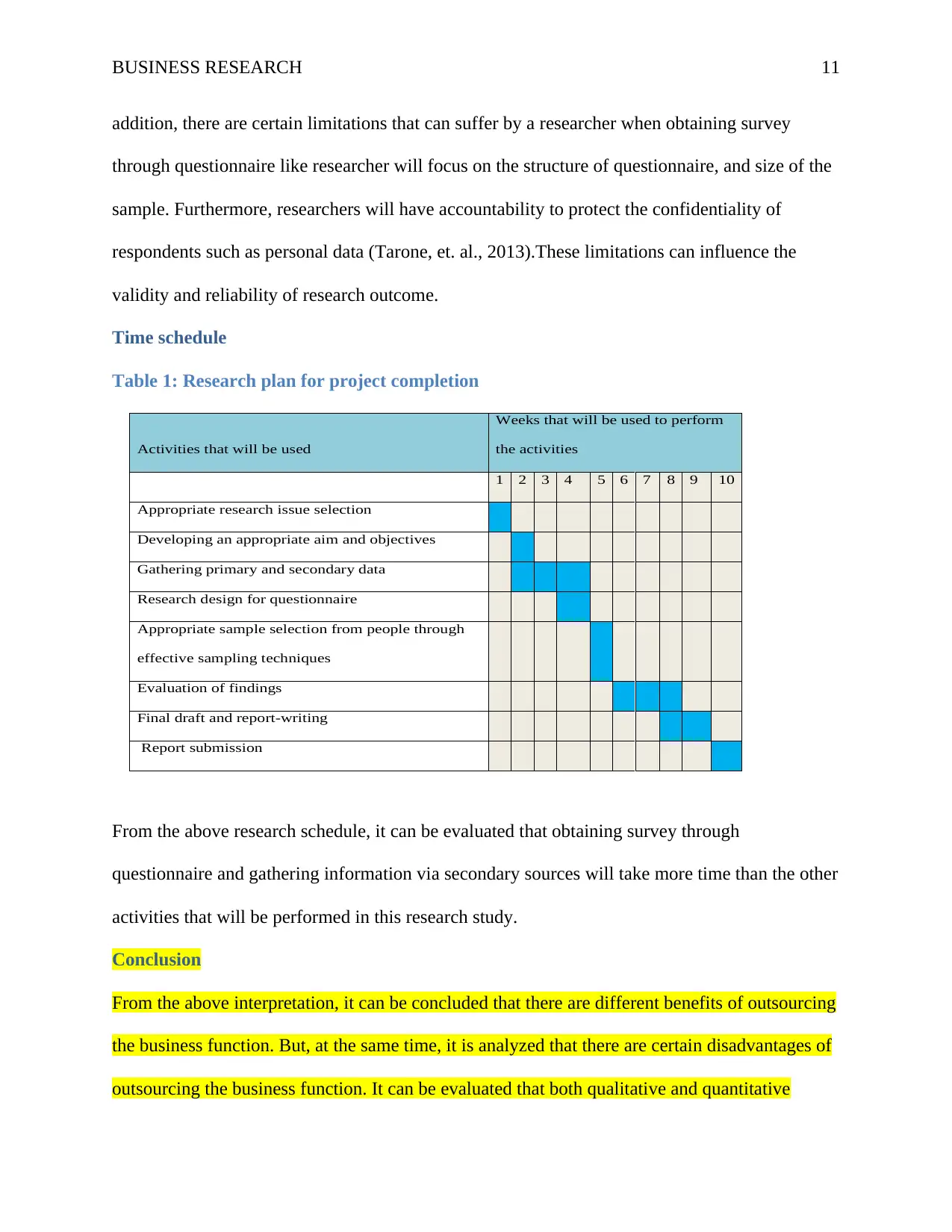
BUSINESS RESEARCH 11
addition, there are certain limitations that can suffer by a researcher when obtaining survey
through questionnaire like researcher will focus on the structure of questionnaire, and size of the
sample. Furthermore, researchers will have accountability to protect the confidentiality of
respondents such as personal data (Tarone, et. al., 2013).These limitations can influence the
validity and reliability of research outcome.
Time schedule
Table 1: Research plan for project completion
Activities that will be used
Weeks that will be used to perform
the activities
1 2 3 4 5 6 7 8 9 10
Appropriate research issue selection
Developing an appropriate aim and objectives
Gathering primary and secondary data
Research design for questionnaire
Appropriate sample selection from people through
effective sampling techniques
Evaluation of findings
Final draft and report-writing
Report submission
From the above research schedule, it can be evaluated that obtaining survey through
questionnaire and gathering information via secondary sources will take more time than the other
activities that will be performed in this research study.
Conclusion
From the above interpretation, it can be concluded that there are different benefits of outsourcing
the business function. But, at the same time, it is analyzed that there are certain disadvantages of
outsourcing the business function. It can be evaluated that both qualitative and quantitative
addition, there are certain limitations that can suffer by a researcher when obtaining survey
through questionnaire like researcher will focus on the structure of questionnaire, and size of the
sample. Furthermore, researchers will have accountability to protect the confidentiality of
respondents such as personal data (Tarone, et. al., 2013).These limitations can influence the
validity and reliability of research outcome.
Time schedule
Table 1: Research plan for project completion
Activities that will be used
Weeks that will be used to perform
the activities
1 2 3 4 5 6 7 8 9 10
Appropriate research issue selection
Developing an appropriate aim and objectives
Gathering primary and secondary data
Research design for questionnaire
Appropriate sample selection from people through
effective sampling techniques
Evaluation of findings
Final draft and report-writing
Report submission
From the above research schedule, it can be evaluated that obtaining survey through
questionnaire and gathering information via secondary sources will take more time than the other
activities that will be performed in this research study.
Conclusion
From the above interpretation, it can be concluded that there are different benefits of outsourcing
the business function. But, at the same time, it is analyzed that there are certain disadvantages of
outsourcing the business function. It can be evaluated that both qualitative and quantitative
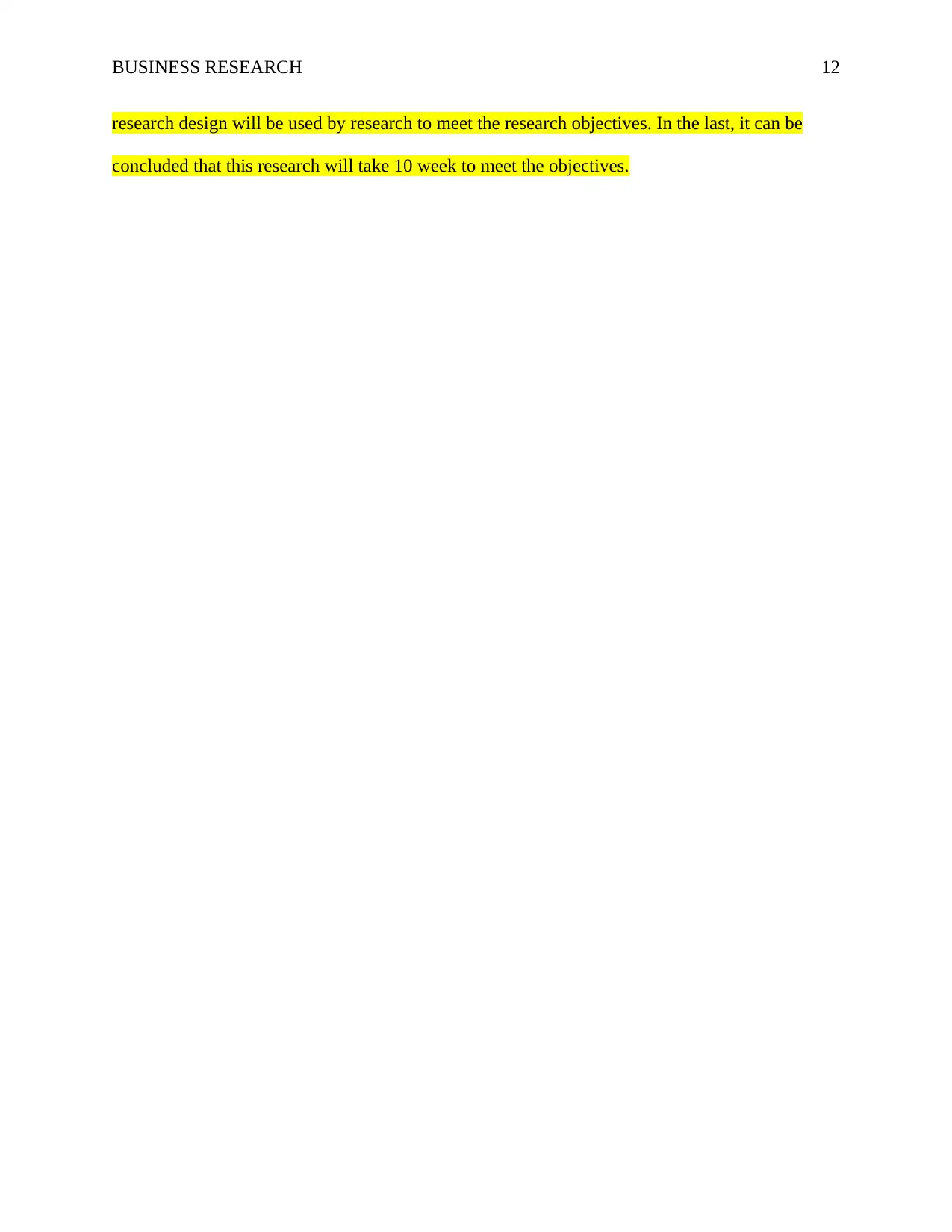
BUSINESS RESEARCH 12
research design will be used by research to meet the research objectives. In the last, it can be
concluded that this research will take 10 week to meet the objectives.
research design will be used by research to meet the research objectives. In the last, it can be
concluded that this research will take 10 week to meet the objectives.
⊘ This is a preview!⊘
Do you want full access?
Subscribe today to unlock all pages.

Trusted by 1+ million students worldwide
1 out of 15
Related Documents
Your All-in-One AI-Powered Toolkit for Academic Success.
+13062052269
info@desklib.com
Available 24*7 on WhatsApp / Email
![[object Object]](/_next/static/media/star-bottom.7253800d.svg)
Unlock your academic potential
Copyright © 2020–2025 A2Z Services. All Rights Reserved. Developed and managed by ZUCOL.



